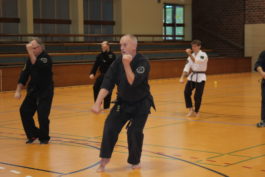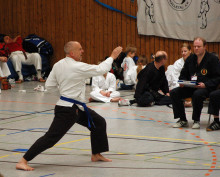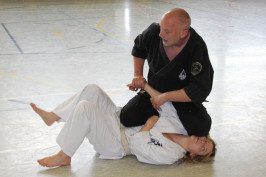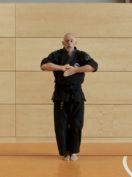The solid stand – or is the movement and rotation rather the central theme? Why is so much emphasis placed on the stand in martial arts?
In primary school, stances are simply part of it. But behind it there is usually little more than a gymnastic exercise. One “goes” to the stand. For hours they work on how the foot position has to be, how deep the stance has to be, how static it looks. And how to “walk with it”. Which, surprisingly, is very strenuous and feels stupid, especially for normal people.
 Stand without statics
Stand without statics
Actually, however, it is more about structure and body tension. I also like to deal with them in detail, whether as a practitioner or as a trainer. But I try to see the stand holistically. Again and again I pay attention to the correct execution, to weight shift, position of the feet, the knees, the pelvis. “Power comes from the earth, the ground.” Through the toes we can feel how we absorb the power, the tension spreading. Putting strain on the outer edges of the foot can be a challenge for a knock-kneed person like me. Knees that are slightly strained outwards help with this perception. Loose in movement, but in the moment of confrontation, of impact, this force – absorbed by the rotating hip work – helps to make the punch or kick really effective.
On the other hand, those who have not yet developed a solid stand, i.e. who have not yet “felt” the static, will not only fail to apply the force in the punch or kick, but also “wobble” in the movement afterwards, always in danger of losing their balance. So in primary school, the foundation is first laid, quite literally. Zenkutsu Dachi, Kiba Dachi, Kokutsu Dachi – high and low, narrow and wide. Later on, the cat and crane position, i.e. Neko Ashi Dachi and Tsuri Ashi Dachi.
In the different Kata one continues to work on it. The deeper and more spacious the stands, the better a form looks. But from here it becomes difficult. Because everyone who competes in tournaments knows this: a little deeper, a little more elegant in the final position. In many cases, this has an effect on the primary school: the stands are lower, they are considered to be cleaner. In movement, the head should even remain at the same height, so the trainee can’t even get up when running forwards or backwards. And in today’s Shotokan and many other styles this even becomes a mostly linear movement, i.e. only back and forth.
But exactly this fixation on the low level in a line leads completely astray in my opinion. Anyway, when it comes to martial arts (and not sports). As a means of strengthening muscles and building up a good “ground feeling”, deep stances also have their meaning. But when you look over the garden fence, every halfway intelligent person realizes: something is wrong. Classic boxers depend on fast hands, hard hits and quick avoidance movements. After all, they only have their hands. The stand is a natural one, feet shoulder-wide apart. Tae kwondoka are experts at using their feet. In battle the same position: shoulder-wide, always extremely agile and fast. Only in the moment of the hit it is fixed, so that the opponent can be knocked down. Also in Silat, where the fight is even more intense with rotation and ground work: basic position shoulderwide and almost upright.
 Low positions are no good
Low positions are no good
If I want to or have to fight, low positions tend to hinder me. And if I’m attacked, the worst movement is the one that takes me straight back. If an opponent attacks me, he will try to move his power in my direction. If I stubbornly go backwards, he will follow me and build up, similar to a wave, to ever stronger penetrating power. Because he is always faster in going forward than I am in going backward.
So I have to get out of the attack direction. And already I am in the high art of attack and defense angles. If I manage to move sideways forwards, I can already stand super, because I am close to the attacker and diagonally to his side.
Fair enough, but just ‘standing there’ doesn’t help me either, because otherwise the attacker will simply turn around with me and hit me. So I have to take action myself. And I can only do this (meaningfully) if I have taken a stable position myself. So I have to go out of the direction so that I can stand stable but still react flexibly. And if possible always! This is only possible if I have distributed my body weight on both feet. If you wobble during the avoidance movement, you are doing something wrong and you have to keep practicing, practicing, practicing.
 Because although the stand is quite natural and very easy, it is not so easy to take it. So in advanced training the focus should not be on the stand, but on moving into it! The movement should be trained, not the “locked” end position. Because there is no end position when I fight. As soon as I have shot my energy, collected from movement and body rotation, in the direction of the opponent, whether as a kick or a punch, I resume my natural, mostly shoulder-wide fighting position.
Because although the stand is quite natural and very easy, it is not so easy to take it. So in advanced training the focus should not be on the stand, but on moving into it! The movement should be trained, not the “locked” end position. Because there is no end position when I fight. As soon as I have shot my energy, collected from movement and body rotation, in the direction of the opponent, whether as a kick or a punch, I resume my natural, mostly shoulder-wide fighting position.
If that is understood and works, then from now on it is only fun. I stand safe in the fight, the opponent on my side. The following body rotation towards the attacker now puts me in an ideal own attacking position. And as I stand on both feet, I have full control over my own weapons, i.e. fists, elbows, knees, feet etc. In Silat this avoidance movement with slight rotation is called “Gelek”. And practiced over and over again. For me personally it is the most valuable treasure I have been allowed to learn here so far.
For some time now, I have been incorporating the gelek into all the partner exercises, the kumite, that I have learned and practiced over the past years. And lo and behold: Suddenly mere sequences of movements become really meaningful fighting situations. It requires a little practice and reflection to recognize the right angles. But I have already written about detective work and the fun of discovering exactly these fighting elements in elementary school.
Up and down
And lifting and lowering is now also gaining in importance. Our body is built to survive a frontal confrontation reasonably unharmed. But what ribs, collarbones or stomach don’t like at all is a brutal hit from below or above into the centre. If I manage to make myself a little bigger and then take my decreasing weight with me in attack energy, I not only have a stronger punch but also a better angle of action. If I alternatively “emerge” from below, then I don’t need much strength at all to do quite a lot of damage to the opponent’s body with my fist, whether on the liver, kidney, under the chin or “just” under the ribs.
Also, when I’m up against bigger and stronger opponents, I need every opportunity to increase my punching power. Okay, I usually don’t have to make myself heavier (sigh), but eventually I teach lighter contemporaries. And they depend on getting their kilograms behind their fists or feet by rotating and lifting and lowering.
If I now take what I have learned seriously, my Kempo will change. With far-reaching consequences. Because if I also take our Tai Tsuku and Saifa seriously as traditional martial arts knowledge, then I have to adapt my stances and movements. All Kata are only meaningful if they are “fought”. So if the imaginary opponent is actually fended off and then defeated. But if I have recognized that most of the low stances (not all!) are nonsense and if the appropriate avoidance movements are missing, then I must consequently also change the Kata, so that it makes fighting sense.
If I train the Kata as a gymnastic exercise, then I go into the deep stances. The deeper, the more strenuous. And nice especially for judges at tournaments. But if I train Kata the way its forefathers developed it, then stands are not the central element, but the movement and the angles to the opponent, the body rotations and avoidance movements, the flexibility and the effectiveness. Insecure stances must be avoided at all costs, because in real combat they are deadly. Unfortunately especially for yourself …








